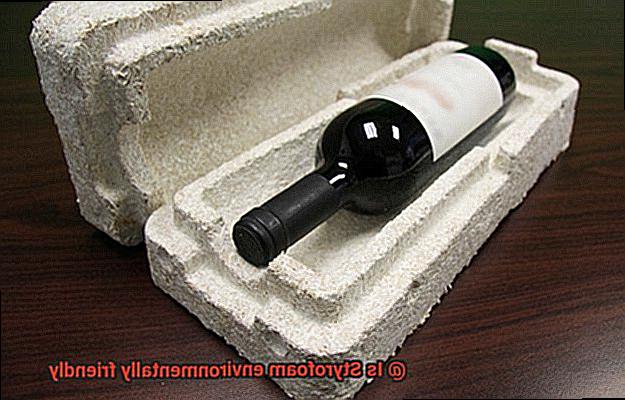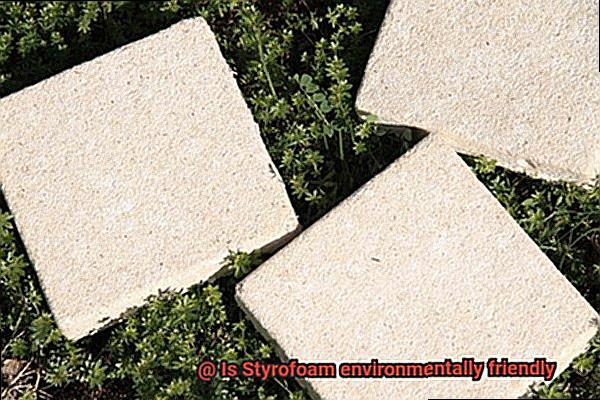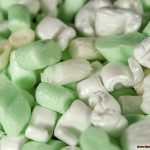Have you ever wondered if Styrofoam is environmentally friendly? It’s a question that has sparked heated debates among scientists, environmentalists, and everyday consumers for decades.
Styrofoam has been a go-to material in the food and beverage industry due to its insulating properties and convenience. However, there is growing concern about its impact on the environment. This plastic material is made from polystyrene, which takes hundreds of years to break down and is non-biodegradable.

In this blog post, we’ll delve into the pros and cons of Styrofoam and shed light on whether it’s truly an eco-friendly option. We’ll explore the manufacturing process of Styrofoam, potential health hazards associated with its use, and its impact on our planet.
You might be surprised to learn that several cities and countries have banned Styrofoam due to its negative environmental impact. As consumers, it’s important to understand how our choices affect the planet.
Are you ready to learn more about the impact of Styrofoam? This blog post will provide you with all the facts you need to make informed decisions moving forward. So let’s dive in.
What is Styrofoam?
Contents
Let’s dive into the world of Styrofoam to understand its impact on our planet.
Styrofoam is actually a brand name for polystyrene foam, a type of plastic derived from petroleum. It’s commonly used in the packaging industry for its lightweight nature and excellent insulation properties, making it perfect for keeping food and drinks hot or cold. However, the production process involves harmful chemicals like benzene and styrene, which can cause health issues for workers and pollute our air and water. Additionally, the production of polystyrene foam generates a significant amount of greenhouse gas emissions, contributing to climate change.
But that’s not all. One of the biggest issues with Styrofoam is that it’s non-biodegradable. This means that it doesn’t break down naturally in the environment and can take hundreds of years to decompose. As a result, Styrofoam waste accumulates in landfills and oceans, causing harm to wildlife and ecosystems. When Styrofoam is incinerated, it releases toxic chemicals into the air, contributing to air pollution and climate change.
However, there is hope for a more sustainable future. Many cities and countries have already taken steps to ban or restrict Styrofoam use, and alternatives are becoming more widely available and affordable. Biodegradable plastics made from plant-based sources, paper-based packaging, and reusable containers are just some examples.
Pros and Cons of Styrofoam
Styrofoam, also known as expanded polystyrene foam, has been a go-to material for packaging and insulation for years. But before you decide to use Styrofoam, it’s important to consider its pros and cons. As an expert on this topic, let me walk you through them.
On the pro side, Styrofoam has some benefits worth mentioning. Firstly, it’s lightweight and easy to transport, reducing the carbon footprint during transportation. This makes it a popular choice for shipping fragile items like electronics or glassware. Secondly, Styrofoam is durable and can withstand high levels of pressure, making it ideal for packaging fragile items. It’s also resistant to moisture and chemicals, which ensures the safety of the product inside. Thirdly, Styrofoam has excellent insulation properties, which makes it a popular choice for keeping food and beverages at the desired temperature. This is why it’s commonly used in disposable coffee cups or take-out containers.
However, on the con side, there are some serious drawbacks to using Styrofoam. Firstly, Styrofoam is non-biodegradable and takes hundreds of years to decompose. This means that every piece of Styrofoam ever produced still exists in some form today. Worse yet, it can cause harm to wildlife by being ingested or entangled in it. Secondly, Styrofoam is a major source of litter and pollution in landfills and oceans. It’s estimated that 1.5 million tons of Styrofoam are thrown away each year, with much of it ending up harming marine life in our waterways. Finally, the manufacturing process of Styrofoam involves the use of toxic chemicals that can pose health risks to workers and nearby communities. These chemicals can also be released into the environment during production or when Styrofoam is disposed of improperly.
Environmental Impact of Styrofoam
Styrofoam, also known as expanded polystyrene (EPS), may be commonly used for packaging and insulation due to its lightweight nature and ability to keep products safe during transportation, but it’s not worth the detrimental impact it has on our environment.
One of the most significant problems with Styrofoam is its decomposition rate. This material takes hundreds of years to decompose, which implies that every single piece ever produced still exists today, taking up valuable space in our landfills and oceans. Dumping Styrofoam in landfills does not break it down over time, continually taking up space while its lightweight nature makes it an easy target for the wind, leading to nearby waterways where it becomes a severe threat to marine life.
The production process of Styrofoam poses an even more significant risk to the environment. The process involves the use of styrene, a toxic chemical that can cause respiratory problems and cancer. The use of styrene in Styrofoam production poses a risk to workers’ health and safety. Therefore, not only does Styrofoam pose a threat to our environment, but it also puts people’s lives at risk.
In addition, recycling Styrofoam is also a challenge. While some facilities can recycle Styrofoam, the process is not cost-effective and requires specialized equipment. As a result, most Styrofoam ends up in landfills or oceans, contributing to environmental pollution.
Health Risks of Styrofoam
Styrofoam, or polystyrene, is commonly used in disposable plates, cups, take-out containers, and packaging materials. However, it poses significant harm to both humans and the environment.
When Styrofoam is heated or exposed to acidic substances, it can release a toxic chemical called styrene. This chemical can cause respiratory problems like coughing and wheezing, skin irritation, and gastrointestinal issues. To make matters worse, the International Agency for Research on Cancer (IARC) has classified styrene as a possible human carcinogen. So, it’s essential to avoid Styrofoam products to limit our exposure to this harmful chemical.
Moreover, discarded Styrofoam products take hundreds of years to decompose in landfills, contributing to environmental pollution. As they break down into smaller pieces, they can be ingested by wildlife, leading to choking or gastrointestinal blockages. Additionally, Styrofoam litter can contaminate water sources and release toxic chemicals into the environment.
The health risks and environmental impact of Styrofoam are alarming. It’s high time we switch to more sustainable alternatives like paper or bamboo products to protect both our health and environment. Many cities and businesses have already implemented bans or restrictions on Styrofoam products in an effort to promote eco-friendly options.
Alternatives to Styrofoam
Fear not, because there are plenty of eco-friendly alternatives to this material. Styrofoam, also known as polystyrene foam, has been a popular choice in the packaging and food industry due to its insulating properties and light weight. Unfortunately, it is also non-biodegradable and takes over 500 years to decompose. As a result, it pollutes our landfills and oceans and harms wildlife.
Luckily, there are several greener choices available. One of the most popular options is biodegradable packaging made from materials like cornstarch or sugarcane fiber. These materials decompose quickly and can be composted, reducing waste and pollution significantly. This solution is ideal for those who want to continue using disposable packaging but in a more sustainable way.
Another alternative is paper-based packaging. It is recyclable, biodegradable, and more durable than Styrofoam. This type of packaging can be used for a wide range of products, from food containers to shipping boxes. In comparison to Styrofoam, paper-based packaging does not harm the environment.
Interestingly, some companies have started using mushrooms and seaweed as alternatives to Styrofoam. These materials are biodegradable and sustainable, making them an excellent option for those looking to reduce their environmental impact. The use of these materials creates a circular economy where waste is minimized by reusing it as a resource.
Reusable containers made from materials such as glass or stainless steel are another fantastic alternative to Styrofoam packaging. They can be washed and reused multiple times, significantly reducing waste. Investing in reusable containers is an easy way to make a difference while also saving money in the long run.
Legislation and Regulations on the Use of Styrofoam
Europe was one of the first regions to take a stand against Styrofoam, with Germany banning Styrofoam containers for food and beverages in 199As a result, other countries like France, Italy, and Spain followed suit. The European Union has also proposed a complete ban on Styrofoam products by 2021.
Across the pond in the United States, many cities and states have also implemented bans on Styrofoam use. San Francisco was the first to ban the sale and distribution of Styrofoam products in 2007, with New York City following in 201Maine became the first state to ban Styrofoam food containers in 2019, with Maryland and Vermont also implementing bans shortly after. While some places have put taxes or fees on Styrofoam products to discourage their use, Washington DC imposes a 6 cent fee on each disposable foam container sold or provided by food establishments.
These regulations are crucial in reducing the amount of Styrofoam that ends up in landfills or as litter in the environment. While they may not completely solve the problem of Styrofoam waste, they are an important step towards creating a more sustainable future for our planet.
It’s important to note that there are plenty of eco-friendly alternatives available such as biodegradable packaging made from cornstarch or sugarcane fiber, paper-based packaging, and even mushroom or seaweed alternatives that create a circular economy. Additionally, reusable containers made from glass or stainless steel can be washed and used multiple times.
wmIzhYIzCX0″ >
Conclusion
To sum up, the Styrofoam debate has been raging for decades. Unfortunately, the facts are clear: Styrofoam is not environmentally friendly. Its production process involves toxic chemicals that harm workers and pollute our air and water. Worse still, it takes hundreds of years to decompose and accumulates in landfills and oceans, harming wildlife and ecosystems.
But don’t despair – there are plenty of eco-friendly alternatives available. Biodegradable packaging made from cornstarch or sugarcane fiber, paper-based packaging, and even mushroom or seaweed alternatives can all create a circular economy. And if you’re looking for something more durable, reusable containers made from glass or stainless steel can be washed and used multiple times.
Thankfully, many cities and countries have already taken action to ban or restrict Styrofoam use. Germany was one of the first regions to take a stand against Styrofoam by banning it in 199In the United States, many cities and states have also implemented bans on Styrofoam use.
As consumers, we hold immense power in choosing sustainable options over harmful ones. By opting for eco-friendly alternatives to Styrofoam, we can significantly reduce waste and pollution while protecting our health and environment.





